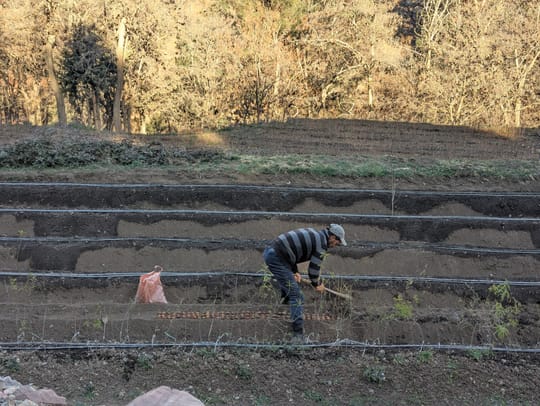On the Cusp of Change – Walnut Distribution in Tadmamt, Al Haouz

By Elle Houby
16 February 2016
A mere forty-five minute drive from the rhythmic commotion that is Marrakesh, Morocco’s southern metropolis, sits the lush nursery of Tadmamt. As spring edges closer, the intricately terraced fields make for a refreshing change of scenery after the vibrant urban scene. Yet, enveloped in the lofty peaks of the High Atlas region and tucked away at the end of a winding dirt road, the nursery itself is a place few stumble upon by chance.
The nursery, rich in a history of walnut production, welcomed an exceptional number of visitors for a tree distribution ceremony in early February. The air was thick with excitement as 28 men from surrounding communes admired around 14,860 walnut saplings, representing great potential for the enthusiastic recipients and the associations and municipalities they represent.
“We have a wonderful saying in Morocco: ‘they plant and we eat, we plant and they eat’”, Abdeljalil Ait Ali, a member of an Oukaimeden association, explained when asked about the significance of each sapling. “The distribution of these walnut trees is of great benefit, not only for our association but also for our families, including our children and grandchildren. The reward they bring will be shared in a generous and inclusive manner.”
Global prices and demand for walnuts is continuing to grow and consumers in the US and Europe seek ever greater amounts of organic product. The fact that walnuts are a hot commodity is one that nursery caretaker Omar Outazgui knows well. As he bundles, counts and distributes the saplings, his energetic hands testify to the expertise of many years. “I began working with plants when I was twelve years old; since then I have tended many different types of trees, such as almond, olive, pomegranate, and, of course, walnut,” Omar explains.
High altitude regions such as Tadmamt provide an ideal environment for walnut trees to thrive. Just as saplings are starting to be distributed to local farmers and associations, fresh land is being turned and new seeds planted, almond being among them. These and other changes are being introduced as the nursery at Tadmamt, owned and managed by Morocco’s High Commission for Water and Forests which, since 2008, has joined in partnership with the High Atlas Foundation (HAF), a Moroccan-U.S. non-governmental organization, enabling HAF to establish organic fruit tree nurseries on such land. When the saplings mature they are distributed to surrounding communities, free of charge as part of the HAF’s One Billion Tree Campaign.
“In Al Haouz province there are currently 300,000 walnut trees, amounting to 34% of Morocco’s walnut production. In the past week alone, we distributed around 28,400 trees at Tadmamt and Imegdale – that’s approaching 10% of the entire amount of walnut trees in the whole province!” HAF President Dr. Yossef Ben-Meir enthuses. “Numerous and diverse civil, public, communal and cooperative entities become partners in the campaign, each playing an essential role. The essential catalyst is the Department of Waters and Forests and the fight against desertification, who have giventhe land for the nursery.”
In the particular case of Tadmamt, the partnership was a four-way one together with the United Nations Development Programme (UNDP) and YSL Beauté, whose support goes toward training members of the Aboghlo Women’s Cooperative in nursery maintenance. HAF partnerships, in sum, form a mosaic of national and international cooperation, working together to benefit those affected by rural poverty throughout Morocco.
Concludes Ben-Meir “were each of the 700 hundred parcels of land managed by the High Commission for Water and Forests in Morocco put to maximum use for organic fruit tree agriculture, this would generate between 80 and 100 million plants each year. Our pilot project together constitutes a real breakthrough.” In the words of Mohammed Issoual, the Marrakesh Regional Director of Water and Forests of the High Atlas region, this partnership and the resulting project represents the essence of Morocco’s forestry strategy. “The distribution of fruit trees in Tadmamt is a vital action for the empowerment of communities and their capacity to protect the environment.”
The strategic vision of the High Commission for Waters and Forests and Desertification Control in this area has a perspective of integrated governance, natural resources, and takes into account the characteristics of each region. What follows is a participatory approach mobilizing and institutionalizing partnerships between different stakeholders including the local population and NGOs. This makes the local population a development actor that raises its own projects, boosts local socioeconomic wheel, creates wealth, and values all products without compromising the sustainability of the forest.
Systemic poverty in Morocco remains an impediment to the prosperity of rural people. According to a recent Carnegie Endowment study, half the Kingdom’s population – and three-quarters of those below the national poverty line – live in rural areas. The key to sustainable prosperity then, lies in the practiced hands of those who, like Omar, live and work, hope and dream in Morocco’s sparkling mountain air.